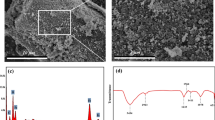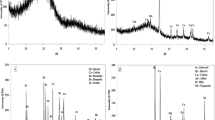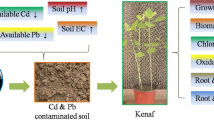Abstract
A series of 60-day soil immobilized incubations were performed to explore the impacts of various factors (incubation time, chitosan modified magnetic sawdust hydrochar (CMSH) dosages, initial pH values, moisture contents, and humic acid (HA)) on CMSH immobilization of Pb and Zn. DTPA and BCR extraction techniques were undertaken to study the distribution of form transformations of Pb and Zn. CMSH showed significant immobilization ability for both DTPA-Pb and DTPA-Zn, and the highest removal rates were shown to be 57.40% and 90.00% for Pb and Zn respectively. After 60 days of incubation, the residual Pb was enhanced by 34–61% and residual Zn increased by 25–41%, which indicated that CMSH was effective in immobilizing Pb and Zn. Meanwhile, the immobilization efficiency improved with increasing incubation time, CMSH dosage, HA dosage, and initial solution pH. In particular, 5% HA application increased the soil TOC and accelerated the metal stabilization processes, with the residual forms of Pb and Zn eventually reaching a maximum of 73% and 71%, respectively. In addition, the alkaline initial solution promoted the ion exchange, surface complexation reaction, and cationic-π interaction, resulting in a better immobilization of Pb and Zn by CMSH. Finally, according to the orthogonal analysis of BCR results, HA dosage was the major factor affecting Pb and Zn immobilization by CMSH compared to soil pH and moisture content in this study.
Graphical abstract





Similar content being viewed by others
Data availability
Not applicable.
References
Bandara T, Chathurika JBAJ, Franks A et al (2021) Interactive effects of biochar type and pH on the bioavailability of As and Cd and microbial activities in co-contaminated soils. Environ Technol Innov 23:101767
Binglin SU, Sun M, Lin J et al (2019) Immobilization of cadmium in soil by green synthesized iron oxide nanoparticles. Acta Sci Circum 39:908–916
Bolan N, Kunhikrishnan A, Thangarajan R et al (2014) Remediation of heavy metal(loid)s contaminated soils – to mobilize or to immobilize? J Hazard Mater 266:141–166
Busch D, Stark A, Kammann CI et al (2013) Genotoxic and phytotoxic risk assessment of fresh and treated hydrochar from hydrothermal carbonization compared to biochar from pyrolysis. Ecotoxicol Environ Saf 97:59–66
Cao X, Harris W (2010) Properties of dairy-manure-derived biochar pertinent to its potential use in remediation. Biores Technol 101:5222–5228
Cao X, Ma L, Liang Y et al (2011) Simultaneous immobilization of lead and atrazine in contaminated soils using dairy-manure biochar. Environ Sci Technol 45:4884–4889
Corguinha A, Souza G, Gonalves VC et al (2014) Assessing arsenic, cadmium, and lead contents in major crops in Brazil for food safety purposes. J Food Compos Anal 37:143–150
Du H, Huang Q, Lei M et al (2018) Sorption of Pb(II) by nanosized ferrihydrite organo-mineral composites formed by adsorption versus coprecipitation. Acs Earth Space Chem 2:556–564
El-Naggar A, Shaheen SM, Ok YS et al (2018) Biochar affects the dissolved and colloidal concentrations of Cd, Cu, Ni, and Zn and their phytoavailability and potential mobility in a mining soil under dynamic redox-conditions. Sci Total Environ 624:1059–1071
Feng J, Yu Q, He A et al (2021) Accelerating Cu and Cd removal in soil flushing assisted by regulating permeability with electrolytes. Chemosphere 281:130883
Guo H, Nasir M, Lv J et al (2017) Understanding the variation of microbial community in heavy metals contaminated soil using high throughput sequencing. Ecotoxicol Environ Saf 144:300–306
Hataf N, Ghadir P, Ranjbar N (2018) Investigation of soil stabilization using chitosan biopolymer. J Clean Prod 170:1493–1500
Hou P, Feng Y, Wang N et al (2020) Win-win: application of sawdust-derived hydrochar in low fertility soil improves rice yield and reduces greenhouse gas emissions from agricultural ecosystems. Sci Total Environ 748:142457
Huang F, Zhang S, Wu R et al (2021) Magnetic biochars have lower adsorption but higher separation effectiveness for Cd2+ from aqueous solution compared to nonmagnetic biochars. Environ Pollut 275:116485
Jiang T, Jiang J, Xu R et al (2012) Adsorption of Pb(II) on variable charge soils amended with rice-straw derived biochar. Chemosphere 89:249–256
Jiang Z, Guo Z, Peng C et al (2021) Heavy metals in soils around non-ferrous smelteries in China: Status, health risks and control measures. Environ Pollut 282:117038
Jindo K, Suto K, Matsumoto K et al (2012) Chemical and biochemical characterisation of biochar-blended composts prepared from poultry manure. Biores Technol 110:396–404
Kumar A, Joseph S, Tsechansky L et al (2018) Biochar aging in contaminated soil promotes Zn immobilization due to changes in biochar surface structural and chemical properties. Sci Total Environ 626:953–961
Lee M-H, Han S-J, Lee YK et al (2020) Enhancing copper binding property of compost-derived humic substances by biochar amendment: further insight from two-dimensional correlation spectroscopy. J Hazard Mater 390:121128
Li G, Khan S, Ibrahim M et al (2018) Biochars induced modification of dissolved organic matter (DOM) in soil and its impact on mobility and bioaccumulation of arsenic and cadmium. J Hazard Mater 348:100–108
Li J, Zhang Y, Wang F et al (2021a) Arsenic immobilization and removal in contaminated soil using zero-valent iron or magnetic biochar amendment followed by dry magnetic separation. Sci Total Environ 768:144521
Li R, Zhang Y, Deng H et al (2020) Removing tetracycline and Hg(II) with ball-milled magnetic nanobiochar and its potential on polluted irrigation water reclamation. J Hazard Mater 384:121095
Li Y, Gong X, Xiong J et al (2021b) Different dissolved organic matters regulate the bioavailability of heavy metals and rhizosphere microbial activity in a plant-wetland soil system. J Environ Chem Eng 9:106823
Liao Q, He L, Tu G et al (2021) Simultaneous immobilization of Pb, Cd and As in soil by hybrid iron-, sulfate- and phosphate-based bio-nanocomposite: Effectiveness, long-term stability and bioavailablity / bioaccessibility evaluation. Chemosphere 266:128960
Lindsay WL, Norvell WA (1978) Development of a DTPA soil test for zinc, iron, manganese, and copper. Soil Sci Soc Am J 42:421–428
Liu D, Ma J, Sun Y et al (2016) Spatial distribution of soil magnetic susceptibility and correlation with heavy metal pollution in Kaifeng City. China Catena 139:53–60
Liu T, Chen Z, Li Z et al (2021) Preparation of magnetic hydrochar derived from iron-rich Phytolacca acinosa Roxb. for Cd removal. Sci Total Environ 769:145159
Lu H, Zhang W, Yang Y et al (2012) Relative distribution of Pb2+ sorption mechanisms by sludge-derived biochar. Water Res 46:854–862
Luo Y, Li Z, Xu H et al (2022) Development of phosphorus composite biochar for simultaneous enhanced carbon sink and heavy metal immobilization in soil. Sci Total Environ 831:154845
Lwin CS, Lee M, Kim Y-N et al (2022) Evaluation of immobilizing agents as soil quality conditioners in addition to their metal(loid) immobilizing effect. Pedosphere 32:307–316
Lynch DH, Voroney RP, Warman PR (2005) Soil physical properties and organic matter fractions under forages receiving composts, manure or fertilizer. Compost Sci Utilization 13:252–261
Ma C, Liu FY, Wei MB et al (2020) Synthesis of novel core-shell magnetic Fe3O4@C nanoparticles with carboxyl function for use as an immobilisation agent to remediate lead-contaminated soils. Pol J Environ Stud 29:2273–2283
Muskus AM, Miltner A, Hamer U et al (2022) Microbial community composition and glyphosate degraders of two soils under the influence of temperature, total organic carbon and pH. Environ Pollut 297:118790
Najafi Z, Golchin A, Alamdari P (2021) Comparison of the efficiency of different chitosan composites in immobilization of chromium in contaminated soils. Arch Agron Soil Sci 1909720. https://doi.org/10.1080/03650340.2021.1909720
Palmborg C, Bringmark L, Bringmark E (1998) Multivariate analysis of microbial activity and soil organic matter at a forest site subjected to low-level heavy metal contamination. AMBIO 27(1): 53–57. https://www.jstor.org/stable/4314685
Qiao D, Wang G, Li X et al (2020) Pollution, sources and environmental risk assessment of heavy metals in the surface AMD water, sediments and surface soils around unexploited Rona Cu deposit, Tibet China. Chemosphere 248:125988
Qu C, Fein JB, Chen W et al (2021) Mechanistic investigation and modeling of Cd immobilization by iron (hydr)oxide-humic acid coprecipitates. J Hazard Mater 420:126603
Quevauviller P, Rauret G, LopezSanchez JF et al (1997) Certification of trace metal extractable contents in a sediment reference material (CRM 601) following a three-step sequential extraction procedure. Sci Total Environ 205:223–234
Rashid M, Sterbinsky GE, MáG Pinilla et al (2018) Kinetic and mechanistic evaluation of inorganic arsenic species adsorption onto humic acid grafted magnetite nanoparticles. J Phys Chem C 122:13540–13547
Rees F, Simonnot MO, Morel JL (2014) Short-term effects of biochar on soil heavy metal mobility are controlled by intra-particle diffusion and soil pH increase. Eur J Soil Sci 65:149–161
Ren J, Zhao Z, Ali A et al (2019) Characterization of phosphorus engineered biochar and its impact on immobilization of Cd and Pb from smelting contaminated soils. J Soils Sediments 20:3041–3052
Rillig MC, Wagner M, Salem M et al (2010) Material derived from hydrothermal carbonization: effects on plant growth and arbuscular mycorrhiza. Appl Soil Ecol 45:238–242
Rinklebe J, Shaheen SM, Frohne T (2016) Amendment of biochar reduces the release of toxic elements under dynamic redox conditions in a contaminated floodplain soil. Chemosphere 142:41–47
Rizwan M, Ali S, Abbas T et al (2018) Residual effects of biochar on growth, photosynthesis and cadmium uptake in rice (Oryza sativa L.) under Cd stress with different water conditions. J Environ Manag 206:676–683
Salam A, Shaheen SM, Bashir S et al (2019) Rice straw- and rapeseed residue-derived biochars affect the geochemical fractions and phytoavailability of Cu and Pb to maize in a contaminated soil under different moisture content. J Environ Manage 237:5–14
Shaheen SM, Rinklebe J, Selim MH (2015) Impact of various amendments on immobilization and phytoavailability of nickel and zinc in a contaminated floodplain soil. Int J Environ Sci Technol 12:2765–2776
Spokas KA, Novak JM, Masiello CA et al (2014) Physical disintegration of biochar: an overlooked process. Environ Sci Technol Lett 1:326–332
Teng F, Zhang Y, Wang D et al (2020) Iron-modified rice husk hydrochar and its immobilization effect for Pb and Sb in contaminated soil. J Hazard Mater 398:122977
Thines KR, Abdullah EC, Mubarak NM et al (2017) Synthesis of magnetic biochar from agricultural waste biomass to enhancing route for waste water and polymer application: a review. Renew Sustain Energy Rev 67:257–276
Turan V, Ramzani PMA, Ali Q et al (2018) Alleviation of nickel toxicity and an improvement in zinc bioavailability in sunflower seed with chitosan and biochar application in pH adjusted nickel contaminated soil. Arch Agron Soil Sci 64:1053–1067
Wagner A, Kaupenjohann M (2015) Biochar addition enhanced growth of Dactylis glomerataL. and immobilized Zn and Cd but mobilized Cu and Pb on a former sewage field soil. Eur J Soil Sci 66:505–515
Wang L, Bolan NS, Tsang DCW et al (2020) Green immobilization of toxic metals using alkaline enhanced rice husk biochar: effects of pyrolysis temperature and KOH concentration. Sci Total Environ 720:137584
Wang Z, Shen R, Ji S et al (2021) Effects of biochar derived from sewage sludge and sewage sludge/cotton stalks on the immobilization and phytoavailability of Pb, Cu, and Zn in sandy loam soil. J Hazard Mater 419:126468
Wu J, Huang R, Zhou Q et al (2021) Magnetic biochar reduces phosphorus uptake by Phragmites australis during heavy metal remediation. Sci Total Environ 758:143643
Wu J, Li Z, Huang D et al (2020) A novel calcium-based magnetic biochar is effective in stabilization of arsenic and cadmium co-contamination in aerobic soils. J Hazard Mater 387:122010
Xia Y, Liu H, Guo Y et al (2019) Immobilization of heavy metals in contaminated soils by modified hydrochar: efficiency, risk assessment and potential mechanisms. Sci Total Environ 685:1201–1208
Xia Y, Luo H, Li D et al (2020) Efficient immobilization of toxic heavy metals in multi-contaminated agricultural soils by amino-functionalized hydrochar: performance, plant responses and immobilization mechanisms. Environ Pollut 261:114217
Xiang J, Lin Q, Yao X et al (2021) Removal of Cd from aqueous solution by chitosan coated MgO-biochar and its in-situ remediation of Cd-contaminated soil. Environ Res 195:110650
Xu X, Cao X, Zhao L (2013) Comparison of rice husk- and dairy manure-derived biochars for simultaneously removing heavy metals from aqueous solutions: role of mineral components in biochars. Chemosphere 92:955–961
Xu X, Hu X, Ting W et al (2021a) Non-inverted U-shaped challenges to regional sustainability: the health risk of soil heavy metals in coastal China. J Clean Prod 279:123746
Xu Y, Qu W, Sun B et al (2021b) Effects of added calcium-based additives on swine manure derived biochar characteristics and heavy metals immobilization. Waste Manage 123:69–79
Yang F, Zhang S, Li H et al (2018a) Corn straw-derived biochar impregnated with α-FeOOH nanorods for highly effective copper removal. Chem Eng J 348:191–201
Yang F, Zhao L, Gao B et al (2016) The interfacial behavior between biochar and soil minerals and its effect on biochar stability. Environ Sci Technol 50:2264–2271
Yang S, Wen Q, Chen Z (2021) Effect of KH2PO4-modified biochar on immobilization of Cr, Cu, Pb, Zn and as during anaerobic digestion of swine manure. Biores Technol 339:125570
Yang X, Igalavithana AD, Oh SE et al (2018b) Characterization of bioenergy biochar and its utilization for metal/metalloid immobilization in contaminated soil. Sci Total Environ 640–641:704–713
Yang Z, Liang L, Yang W et al (2018c) Simultaneous immobilization of cadmium and lead in contaminated soils by hybrid bio-nanocomposites of fungal hyphae and nano-hydroxyapatites. Environ Sci Pollut Res 25:11970–11980
Yu F, Zhu X, Jin W et al (2020) Optimized synthesis of granular fuel and granular activated carbon from sawdust hydrochar without binder. J Clean Prod 276:122711
Yu HY, Li FB, Liu CS et al (2016) Iron redox cycling coupled to transformation and immobilization of heavy metals: implications for paddy rice safety in the red soil of South China. Adv Agron 137:279–317
Yuan Y, Bolan N, Prévoteau A et al (2017a) Applications of biochar in redox-mediated reactions. Biores Technol 246:271–281
Yuan Y, Chai L, Yang Z et al (2017b) Simultaneous immobilization of lead, cadmium, and arsenic in combined contaminated soil with iron hydroxyl phosphate. J Soils Sediments 17:1–8
Zhang DR, Chen HR, Xia JL et al (2020a) Humic acid promotes arsenopyrite bio-oxidation and arsenic immobilization. J Hazard Mater 384:121359
Zhang W, Huang X, Jia Y et al (2017) Metal immobilization by sludge-derived biochar: roles of mineral oxides and carbonized organic compartment. Environ Geochem Health 39:379–389
Zhang W, Tong L, Yuan Y et al (2010) Influence of soil washing with a chelator on subsequent chemical immobilization of heavy metals in a contaminated soil. J Hazard Mater 178:578–587
Zhang Y, Qin J, Yi Y (2020b) Biochar and hydrochar derived from freshwater sludge: characterization and possible applications. Sci Total Environ 763:144550
Zhou Y, Gao B, Zimmerman AR et al (2013) Sorption of heavy metals on chitosan-modified biochars and its biological effects. Chem Eng J 231:512–518
Zibaei Z, Ghasemi-Fasaei R, Ronaghi A et al (2020) Improvement of biochar capability in Cr immobilization via modification with chitosan and hematite and inoculation with Pseudomonas putida. Commun Soil Sci Plant Anal 51:963–975
Funding
The authors received support provided by the Graduate Student Innovation Fund of Donghua University (No. GSIF-DH-M-2021008) and the Natural Science Foundation of Shanghai (No. 22ZR1401700).
Author information
Authors and Affiliations
Contributions
Yitong Dan: conceptualization, writing — original draft, methodology, investigation. Xiaoxia Wang: data curation, visualization, methodology, writing — review and editing. Wenjing Sang: conceptualization, methodology, project administration, funding acquisition, supervision, writing — review and editing. Lei Zhou: methodology, investigation. Yinzhu Diao: methodology, writing — review and editing. Feihong Liu: methodology, writing — review and editing. Huan Wang: methodology, writing — review and editing.
Corresponding author
Ethics declarations
Competing interests
The authors declare no competing interests.
Additional information
Responsible Editor: Zhihong Xu
Publisher's note
Springer Nature remains neutral with regard to jurisdictional claims in published maps and institutional affiliations.
Highlights
• Soil pH reduced while TOC gradually elevated after adding CMSH for 60 days.
• Enhancing CMSH facilitated the conversion of Pb and Zn residual form.
• Increasing moisture content, initial pH, and HA promoted the immobilization of Pb and Zn.
• Compared with other influencing factors, HA has the most significant effect on immobilization of Pb and Zn.
Supplementary Information
Below is the link to the electronic supplementary material.
11356_2022_21745_MOESM1_ESM.docx
Supplementary file1 (DOCX 19 KB) The details of soil characterization were exhibited in S1. Physicochemical properties of the contaminated soil were presented in Table S1.
Rights and permissions
About this article
Cite this article
Dan, Y., Wang, X., Sang, W. et al. Development of chitosan-magnetic sawdust hydrochar for Pb and Zn immobilization process on various soil conditions. Environ Sci Pollut Res 29, 84675–84689 (2022). https://doi.org/10.1007/s11356-022-21745-2
Received:
Accepted:
Published:
Issue Date:
DOI: https://doi.org/10.1007/s11356-022-21745-2




